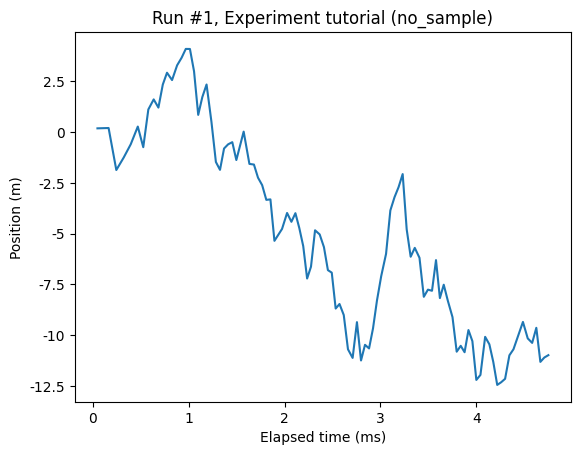This page was generated from
docs/examples/DataSet/Measuring X as a function of time.ipynb.
Interactive online version:
.
Measuring X as a function of time¶
Sometimes we’d like to measure something as a function of elapsed wall clock time. QCoDeS provides a convenient default way of doing such a measurement, namely by using the ElapsedTimeParameter.
The main utility of having a default way of measuring time is the uniformity in data of different experiments.
[1]:
from pathlib import Path
import numpy as np
from qcodes.dataset import (
Measurement,
initialise_or_create_database_at,
load_or_create_experiment,
plot_dataset,
)
from qcodes.parameters import ElapsedTimeParameter, Parameter
Prepatory footwork: setup database and experiment¶
[2]:
initialise_or_create_database_at(
Path.cwd().parent / "example_output" / "x_as_a_function_of_time.db"
)
load_or_create_experiment("tutorial", "no_sample")
[2]:
tutorial#no_sample#1@/home/runner/work/Qcodes/Qcodes/docs/examples/example_output/x_as_a_function_of_time.db
------------------------------------------------------------------------------------------------------------
The measurement itself¶
We’ll measure some Brownian motion. We set up a parameter for the noise.
[3]:
noise = Parameter(
"noise", label="Position", unit="m", get_cmd=lambda: np.random.randn()
)
time = ElapsedTimeParameter("time")
[4]:
meas = Measurement()
meas.register_parameter(time)
meas.register_parameter(noise, setpoints=[time])
[4]:
<qcodes.dataset.measurements.Measurement at 0x7f4a10268f90>
[5]:
with meas.run() as datasaver:
pos = 0
time.reset_clock()
for _ in range(100):
pos += noise()
now = time()
datasaver.add_result((noise, pos), (time, now))
dataset = datasaver.dataset
Starting experimental run with id: 1.
[6]:
axs, cbs = plot_dataset(dataset)

[ ]: